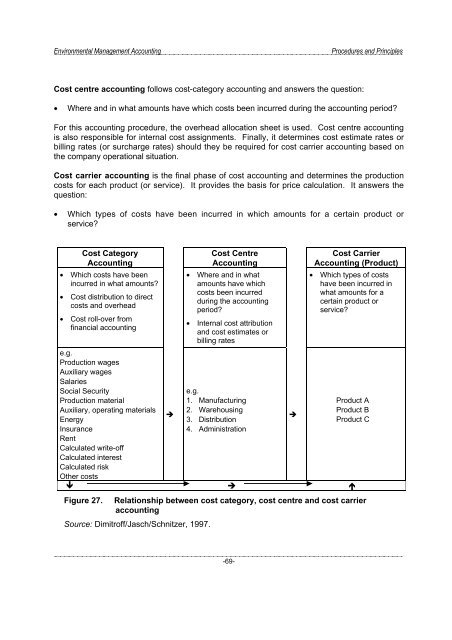Environmental Management Accounting Procedures and Principles
Environmental Management Accounting Procedures and Principles
Environmental Management Accounting Procedures and Principles
Create successful ePaper yourself
Turn your PDF publications into a flip-book with our unique Google optimized e-Paper software.
<strong>Environmental</strong> <strong>Management</strong> <strong>Accounting</strong><br />
<strong>Procedures</strong> <strong>and</strong> <strong>Principles</strong><br />
Cost centre accounting follows cost-category accounting <strong>and</strong> answers the question:<br />
• Where <strong>and</strong> in what amounts have which costs been incurred during the accounting period?<br />
For this accounting procedure, the overhead allocation sheet is used. Cost centre accounting<br />
is also responsible for internal cost assignments. Finally, it determines cost estimate rates or<br />
billing rates (or surcharge rates) should they be required for cost carrier accounting based on<br />
the company operational situation.<br />
Cost carrier accounting is the final phase of cost accounting <strong>and</strong> determines the production<br />
costs for each product (or service). It provides the basis for price calculation. It answers the<br />
question:<br />
• Which types of costs have been incurred in which amounts for a certain product or<br />
service?<br />
Cost Category<br />
<strong>Accounting</strong><br />
• Which costs have been<br />
incurred in what amounts?<br />
• Cost distribution to direct<br />
costs <strong>and</strong> overhead<br />
• Cost roll-over from<br />
financial accounting<br />
e.g.<br />
Production wages<br />
Auxiliary wages<br />
Salaries<br />
Social Security<br />
Production material<br />
Auxiliary, operating materials<br />
Energy<br />
Insurance<br />
Rent<br />
Calculated write-off<br />
Calculated interest<br />
Calculated risk<br />
Other costs<br />
<br />
Cost Centre<br />
<strong>Accounting</strong><br />
• Where <strong>and</strong> in what<br />
amounts have which<br />
costs been incurred<br />
during the accounting<br />
period?<br />
• Internal cost attribution<br />
<strong>and</strong> cost estimates or<br />
billing rates<br />
e.g.<br />
1. Manufacturing<br />
2. Warehousing<br />
3. Distribution<br />
4. Administration<br />
<br />
Cost Carrier<br />
<strong>Accounting</strong> (Product)<br />
• Which types of costs<br />
have been incurred in<br />
what amounts for a<br />
certain product or<br />
service?<br />
Product A<br />
Product B<br />
Product C<br />
<br />
Figure 27. Relationship between cost category, cost centre <strong>and</strong> cost carrier<br />
accounting<br />
Source: Dimitroff/Jasch/Schnitzer, 1997.<br />
-69-




